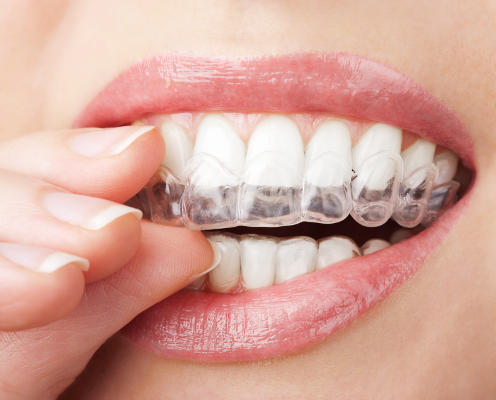Cosmetic Solutions
Cosmetic dentistry is an essential part of our modern life. Besides, nothing is more contagious than a beautiful smile.
Almost everyone these days can appreciate the value of a beautiful smile. It increases our self-confidence and unlocks all of the benefits associated with people that smile more often such as reduced stress, more youthful appearance, and improved mood. If you don’t currently have the beautiful smile you desire we can help achieve this for you with cosmetic dentistry. Through the strategic use of composite restorations (aka “tooth colored fillings”), crowns, bridges, implants, removable prosthesis (such as complete dentures and partial dentures) we can transform patient’s smiles. Our team can perform a thorough examination of your dentition to determine which cosmetic dentistry options will best help you achieve the beautiful smile you deserve.

Tooth Whitening
There is nothing more appealing than a sparkling, white smile. However, our teeth rarely stay as white as we would like them to be without a little help. Fortunately, the help needed to improve your smile is available at the dental office.
Teeth whitening done in a professional dental setting is a safe and effective way to brighten your smile. It is also perhaps the most economical cosmetic dental procedure. Depending on the method of whitening you choose, results can be dramatic. For example, in office whitening can lighten teeth three to eight shades in a single appointment.
Professionally supervised whitening will work faster while protecting sensitive gums and tooth root surfaces better than over the counter whitening products. It is important to have an oral exam before any whitening procedures to make sure your tooth discoloration is not the result of a dental condition in need of treatment. Also, please be aware that it can be risky to have whitening solutions applied to your teeth by untrained personnel in shopping malls. If you have any questions about which whitening method would be best for you, talk to us first.
Porcelain Veneers
What does it take to make a beautiful smile? That is a complex question, but some of the qualities of a lovely smile are immediately identifiable. Good tooth color, shape and alignment are a few of the most important characteristics. If your teeth could use some improvement in any of these categories, porcelain veneers could be just what you are looking for.
Dental veneers are a wafer-thin layer of super strong porcelain that convincingly substitutes for natural tooth enamel. When veneers are bonded to your teeth, they can create a natural looking and beautiful new surface. This is because dental porcelain is translucent and tough like natural tooth enamel. However, porcelain veneers do not stain like tooth enamel does.
There have been remarkable advances in dental porcelain technology in recent years. Veneers can now be made so thin that they can sometimes be bonded directly onto your tooth without altering the existing tooth surface. In other cases, a very thin layer of tooth enamel needs to be removed to fit the new porcelain surface and make it look as lifelike as possible. Either way, the results are sure to make you smile.
Limitations of Porcelain Veneers
There are some situations in which veneers would not be an appropriate treatment option. For example, if you have a large gap or significantly misaligned teeth, orthodontic treatment might be a more appropriate solution than veneers. If you have lost a lot of tooth structure from trauma or decay it might be better to restore your teeth with porcelain crowns that cover the entire tooth.
Improving Your Smile with Porcelain Veneers
The first step in improving your smile with porcelain veneers is a dental evaluation to determine exactly what you do not like about your current smile. It is a great idea to bring in pictures of smiles you do like as a starting point for discussion. Often, steps will be taken to show you the end result of veneers before treatment. A model of your teeth can be created over which wax veneers can be placed and sometimes tooth colored filling materials can be placed directly onto your teeth to demonstrate the effect veneers would have on them.
Once the plan has been agreed upon, your teeth will be prepared by removing a small amount of enamel if necessary. Molds of your teeth will be taken and used by a skilled dental laboratory technician to create your veneers. You will receive a temporary set of veneers to wear during the few weeks it takes to create your permanent veneers. When the veneers come back from the lab, they will be cemented onto your teeth.
Caring for Your Veneers
Just like your natural dentition, teeth restored with veneers need gentle brushing and flossing every day. This will remove dental plaque and ensure good gum tissue health around the veneers. Regular checkups at the dental office will remain an important part of your oral and general health. Keep in mind that as tough as veneers are, they may not be able to withstand forces that come from using your teeth as tools or biting into very hard foods like candy apples. These things are not good for your natural teeth either! If you grind or clench your teeth at night, you might be advised to get a custom made night guard to protect your veneers for years to come.
Crowns
Dentistry is an art as well as a science and dental crowns offer a perfect example of this. A dental crown (often referred to as a “cap”) is a covering that fits over a damaged, decayed, or unattractive tooth. A crown completely covers a tooth unlike a dental veneer, which only covers a tooth’s front surface. Therefore, if a tooth is missing a significant amount of structure above the gum line, a crown would be the restoration of choice.
Crowns strengthen damaged teeth which allows them to function normally again. The high tech porcelain crowns crafted to are virtually indistinguishable from natural teeth. They can even be designed to improve upon a tooth’s original appearance.
There are other materials besides porcelain that we can be used to make dental crowns, depending on what qualities are most important for your case. The long term durability of cast gold crowns cannot be beat, but it is not always the most aesthetic choice. Porcelain fused to metal crowns (PFM) are also available which have a metal interior for strength and a porcelain exterior for a more natural appearance. Another option is a crown made of zirconia which is the strongest ceramic available in dentistry. The pros and cons of all these options will be discussed with you.
Crowning a Tooth
The crowning or capping of a tooth usually is a two to three visit process. At the first visit, your tooth is prepared to receive its new crown. The tooth is shaved down to a uniform shape to allow it to fit inside the new covering. This process is completed while you are numb. In some cases there is very little tooth structure left to begin with which requires the tooth to be built up with filling material in order to support the crown.
After the tooth is prepared, impressions of your teeth are taken, either digitally or with putty like impression materials, and sent to the dental laboratory. There, a skilled technician use the impressions will be used to make models of your teeth for the creation of a crown. The models will serve as guides to ensure that your new crown is designed to enhance your smile and function well within your bite.
Before the end of your first appointment, a temporary crown will be attached to your tooth to protect it until the permanent crown is ready. At the second visit, your permanent crown will be attached to your tooth with either a resin that hardens when exposed to a special light source or a type of permanent cement.
Taking Care of Your Crowns
Crowns require the same level of care as your natural teeth. Be sure to brush and floss between all of your teeth every day to reduce the buildup of dental plaque. When you have crowns, it is even more important to maintain your regular schedule of cleanings at the dental office. If you have a habit of grinding your teeth, wearing a night guard is a good idea to protect your teeth and your investment.
Tooth Colored Fillings (Composite Resins)
There have been great advancements in the field of dentistry over the years. We are now able to restore teeth with tooth colored restorations that allow for more beautiful smiles that mimic natural tooth color. These tooth colored fillings, often called composites or composite resins, are able to effectively restore function while appearing almost exactly the same texture and color as the patient’s natural tooth. Placement of tooth colored fillings often requires less removal of tooth structure which allows for a smaller restoration to be placed. These fillings are “bonded” to tooth structure and then sculpted around the tooth by the dentist in order to achieve an aesthetically pleasing result.
Placement of composite restorations is usually a one-visit procedure. The teeth are prepared by the dentist by removing any decay or fractures. Then the surface of the tooth is etched with a gel and a treatment of bonding agent is applied to the tooth. After the composite is applied and adjusted to the tooth, it is hardened with the use of a high intensity light. It is then buffered and polished to smooth out any rough surfaces.
It is amazing the beauty composite tooth bonding materials can bring to your teeth. Still, with all the advancements in this material, it still has its limitations. How long a composite restoration lasts depends on many factors that are unique to the individual. Many people will go for ten or fifteen years and have the composite restoration look as good as the day it was first placed. Some people will get staining on the margins of the restoration after one or two years and will need some touch-up work. If you take care of a tooth colored restoration well it would be unusual to ever need to have to replace it, but some touch-up work would be normal after three to five years.
Bridges
Missing teeth can cause a noticeable change in in the way we speak and eat. Fortunately we now have many options to restore your smile. Bridges or “fixed partial dentures” are a form of tooth replacement used where a tooth or several teeth are missing. Unlike a removable partial dentures, which can be taken out to clean, a fixed bridge is permanently cemented in and can only be removed by a dentist. They replace missing teeth by attaching to abutments, which are either natural teeth or dental. Fixed bridges are made by placing crowns on the abutments and fusing the crowns to the tooth replacement which is called a pontic. This bridge is then bonded onto the abutments.
The procedure for a bridge usually takes two appointments to complete. At the first appointment the abutment teeth on either side of the gap are prepared by removing a portion of the enamel and dentin. Accurate impressions of the prepared teeth are then taken and sent to a dental laboratory where the bridge will be constructed. A temporary bridge will be made and temporarily cemented while your permanent bridge is being fabricated. It usually takes about three weeks for the bridge to be fabricated by the dental lab. At your second visit, the bridge is adjusted for fit and cemented in place.
Though bridges can be a great restorative option, they are not indicated for all patients. Bridges require support on both sides of the area missing teeth either by other teeth or implants in order to be placed. Also, in situations where the two adjacent teeth are healthy and require no restorations an implant is a much more conservative treatment alternative. If you are interested in replacing a missing tooth, let the team at Blue Wolf Dental review what treatment options may be best for you.

